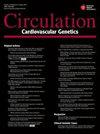Systematic Characterization of Long Noncoding RNAs Reveals the Contrasting Coordination of Cis- and Trans-Molecular Regulation in Human Fetal and Adult Hearts
Q Medicine
引用次数: 44
Abstract
Background—The molecular regulation of heart development is regulated by cis- and trans-factors acting on the genome and epigenome. As a class of important regulatory RNAs, the role of long noncoding RNAs (lncRNAs) in human heart development is still poorly understood. Furthermore, factors that interact with lncRNAs in this process are not well characterized. Methods and Results—Using RNA sequencing, we systematically define the contrasting lncRNA expression patterns between fetal and adult hearts. We report that lncRNAs upregulated in adult versus fetal heart have different sequence features and distributions. For example, the adult heart expresses more sense lncRNAs compared with fetal heart. We also report the coexpression of lncRNAs and neighboring coding genes that have important functions in heart development. Importantly, the regulation of lncRNA expression during fetal to adult heart development seems to be due, in part, to the coordination of specific developmental epigenetic modifications, such as H3K4me1 and H3k4me3. The expression of promoter-associated lncRNAs in adult and fetal hearts also seems to be related to these epigenetic states. Finally, transcription factor–binding analysis suggests that lncRNAs are directly regulating cardiac gene expression during development. Conclusions—We provide a systematic analysis of lncRNA control of heart development that gives clues to the roles that specific lncRNAs play in fetal and adult hearts.长链非编码rna的系统表征揭示了人类胎儿和成人心脏中顺式和反式分子调控的对比协调
心脏发育的分子调控是由作用于基因组和表观基因组的顺式和反式因子调控的。长链非编码rna (long noncoding rna, lncRNAs)作为一类重要的调控rna,在人类心脏发育中的作用尚不清楚。此外,在这一过程中与lncrna相互作用的因子并没有很好地表征。方法与结果:利用RNA测序技术,我们系统地定义了胎儿和成人心脏之间lncRNA的表达模式差异。我们报道,在成人和胎儿心脏中上调的lncrna具有不同的序列特征和分布。例如,成人心脏比胎儿心脏表达更多的sense lncrna。我们还报道了在心脏发育中具有重要功能的lncRNAs和邻近编码基因的共表达。重要的是,在胎儿到成人心脏发育过程中,lncRNA表达的调节似乎部分归因于特定发育表观遗传修饰的协调,如H3K4me1和H3k4me3。启动子相关lncrna在成人和胎儿心脏中的表达似乎也与这些表观遗传状态有关。最后,转录因子结合分析表明lncrna在发育过程中直接调节心脏基因的表达。结论:我们对lncRNA控制心脏发育进行了系统分析,为特定lncRNA在胎儿和成人心脏中发挥的作用提供了线索。
本文章由计算机程序翻译,如有差异,请以英文原文为准。
求助全文
约1分钟内获得全文
求助全文
来源期刊

Circulation-Cardiovascular Genetics
CARDIAC & CARDIOVASCULAR SYSTEMS-GENETICS & HEREDITY
CiteScore
3.95
自引率
0.00%
发文量
0
期刊介绍:
Circulation: Genomic and Precision Medicine considers all types of original research articles, including studies conducted in human subjects, laboratory animals, in vitro, and in silico. Articles may include investigations of: clinical genetics as applied to the diagnosis and management of monogenic or oligogenic cardiovascular disorders; the molecular basis of complex cardiovascular disorders, including genome-wide association studies, exome and genome sequencing-based association studies, coding variant association studies, genetic linkage studies, epigenomics, transcriptomics, proteomics, metabolomics, and metagenomics; integration of electronic health record data or patient-generated data with any of the aforementioned approaches, including phenome-wide association studies, or with environmental or lifestyle factors; pharmacogenomics; regulation of gene expression; gene therapy and therapeutic genomic editing; systems biology approaches to the diagnosis and management of cardiovascular disorders; novel methods to perform any of the aforementioned studies; and novel applications of precision medicine. Above all, we seek studies with relevance to human cardiovascular biology and disease. Manuscripts are examined by the editorial staff and usually evaluated by expert reviewers assigned by the editors. Both clinical and basic articles will also be subject to statistical review, when appropriate. Provisional or final acceptance is based on originality, scientific content, and topical balance of the journal. Decisions are communicated by email, generally within six weeks. The editors will not discuss a decision about a manuscript over the phone. All rebuttals must be submitted in writing to the editorial office.
 求助内容:
求助内容: 应助结果提醒方式:
应助结果提醒方式:


